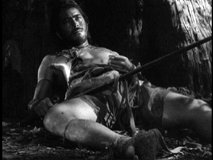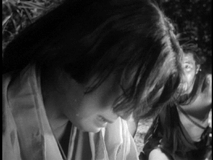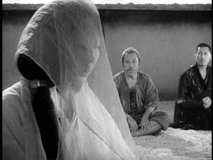Rashomon (Akira Kurosawa) 1950
 Rashomon, the film that first exposed Japanese master Akira Kurosawa to Western audiences, has had so much written about it already that it
feels almost impossible to bring something new to the table while discussing it.
As one of the few foreign films to have entered fully into the American popular
vernacular, it is an important film not only because of its own technical
prowess, but because its Golden Lion win at the Venice Film Festival prompted a
golden age in Japanese cinema. Set in eleventh-century Japan, it tells the same
brief account of a rape and a murder from four different slanted perspectives,
under the pretense that the telling of the truth is a malleable thing, warped by
the self-serving intentions of the storyteller.
Rashomon, the film that first exposed Japanese master Akira Kurosawa to Western audiences, has had so much written about it already that it
feels almost impossible to bring something new to the table while discussing it.
As one of the few foreign films to have entered fully into the American popular
vernacular, it is an important film not only because of its own technical
prowess, but because its Golden Lion win at the Venice Film Festival prompted a
golden age in Japanese cinema. Set in eleventh-century Japan, it tells the same
brief account of a rape and a murder from four different slanted perspectives,
under the pretense that the telling of the truth is a malleable thing, warped by
the self-serving intentions of the storyteller.
 Kurosawa is one storyteller whose intentions are made abundantly clear. He wants
to do nothing less than illustrate the illusory and tremendously personal nature
of reality. To do this, he saturates each recounting of the events in the forest
with shots taken from a subjective, constantly moving camera. The sweaty, frenzy
that characterizes one telling of the story clashes with teary-eyed version
another narrator weaves. Several cinematic elements recur in each episode,
however, with an abundance of complex tracking shots, compositions that resemble
the triangle that powers the dynamic of the event, similar editing rhythms, and
feverish glances skyward throughout. This repetition of visual touchstones
suggests that although each person’s motivation might have differed, feelings
in a broader sense are more similar than different. The cast is uniformly
excellent, especially when considering how they subtly alter their performances
to show the divergence in the perception of their characters. Toshiro Mifune,
Kurosawa’s frequent collaborator, is a particular delight. His exaggerated
performance isn’t naturalistic, but believable nonetheless. The way that he
stops during a duel to scratch himself or plays casually with his sword after
seeing the girl he desires for the first time demonstrates his wonderful
physicality and the sense of humor that he imbues himself with.
Kurosawa is one storyteller whose intentions are made abundantly clear. He wants
to do nothing less than illustrate the illusory and tremendously personal nature
of reality. To do this, he saturates each recounting of the events in the forest
with shots taken from a subjective, constantly moving camera. The sweaty, frenzy
that characterizes one telling of the story clashes with teary-eyed version
another narrator weaves. Several cinematic elements recur in each episode,
however, with an abundance of complex tracking shots, compositions that resemble
the triangle that powers the dynamic of the event, similar editing rhythms, and
feverish glances skyward throughout. This repetition of visual touchstones
suggests that although each person’s motivation might have differed, feelings
in a broader sense are more similar than different. The cast is uniformly
excellent, especially when considering how they subtly alter their performances
to show the divergence in the perception of their characters. Toshiro Mifune,
Kurosawa’s frequent collaborator, is a particular delight. His exaggerated
performance isn’t naturalistic, but believable nonetheless. The way that he
stops during a duel to scratch himself or plays casually with his sword after
seeing the girl he desires for the first time demonstrates his wonderful
physicality and the sense of humor that he imbues himself with.
 Because of the way that he frames us as the judge to the characters’
testimonies, the wonderful, pulsating score seems the most obvious directorial
comment on the events of Rashomon until near the end when Kurosawa’s
humanism starts to rear its head, to the detriment of the picture. The moral
ambiguities of the film are certainly enlightening, but I don’t know that the
rain-soaked hell-on-earth that Kurosawa presents in his framing device is really
deserved. Still, the heavy-handed moralizing of the framing device, and the rank
sentimentalism of the ending don’t seem a much more comfortable fit than the
pessimism (perhaps if we had this story told by another director, one who was
less given to the bathetic, it would be eschewed), so perhaps offering the
entire stew of human experience to us is the right choice, after all.
Because of the way that he frames us as the judge to the characters’
testimonies, the wonderful, pulsating score seems the most obvious directorial
comment on the events of Rashomon until near the end when Kurosawa’s
humanism starts to rear its head, to the detriment of the picture. The moral
ambiguities of the film are certainly enlightening, but I don’t know that the
rain-soaked hell-on-earth that Kurosawa presents in his framing device is really
deserved. Still, the heavy-handed moralizing of the framing device, and the rank
sentimentalism of the ending don’t seem a much more comfortable fit than the
pessimism (perhaps if we had this story told by another director, one who was
less given to the bathetic, it would be eschewed), so perhaps offering the
entire stew of human experience to us is the right choice, after all.
* * * *
04-29-02
Jeremy Heilman